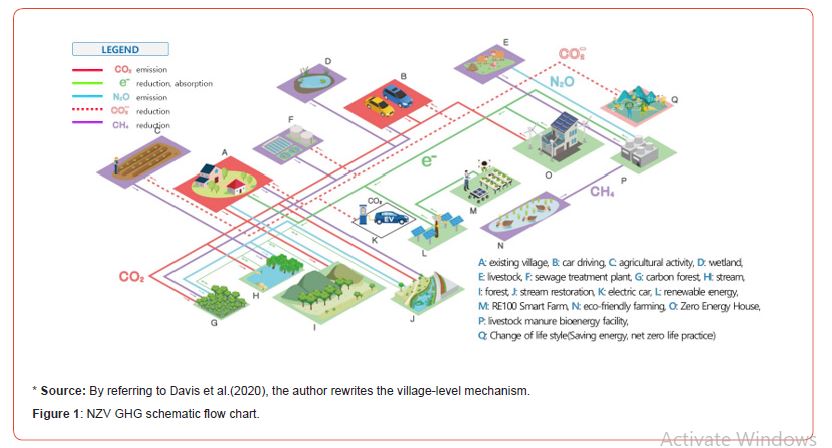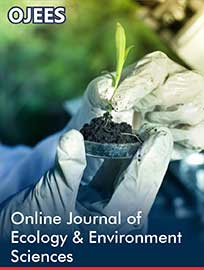 Mini Review
Mini Review
Consideration of the Need for Net Zero Villages to Respond to Climate Change
Dong Kyu Lee*
Senior Manager, Korea Water Resources Corporation, Daejeon, Republic of Korea
Dong Kyu Lee, Korea Water Resources Corporation, 200 Shintanjin-Ro, Daedeok-Gu, Daejeon, 34350 Republic of Korea
Received Date:February 23, 2024; Published Date:March 26, 2024
Abstract
Climate change is a challenge that all humanity must solve, and at the same time, it is a present-day obligation for future generations. To respond to these contemporary challenges, countries around the world are setting goals for Net Zero and promoting various strategies to minimize carbon emissions before 2050. However, detailed implementation plans for this related strategy are insufficient, and implementation plans for Net Zero in major sectors such as energy, transportation, and villages are needed. The purpose of this study is to explore the need for and possibilities for a Net-Zero Village that can lead to Net Zero at the village level. We derived characteristics through analysis of greenhouse gas flows emitted from the village and discussed the possibility of Net Zero based on this.
Keywords:Climate Change; Mitigation and adaptation; Net zero; Villages planning; Greenhouse gas emissions
Introduction
Currently, humanity stands on two paths. One way is to enter the Hothouse Earth region, a stage where the global temperature rises by 4-5°C compared to before industrialization through continuous emission of greenhouse gases, and the other way is to stabilize the climate to a controllable level. He warned that once the hot house Earth stage is entered, it will not be possible to return to the previous state of balance even if various efforts are made on the human level to reduce greenhouse gas emissions. In addition, to prevent entry into the hot house district, it is necessary to drastically reduce greenhouse gas emissions, plant plants that can absorb them, and protect existing forests to balance global energy [1-3]. With the implementation of the Paris Agreement under the Climate Change Agreement, the world is transitioning toward a new direction of ‘Net Zero by 2050’, a stronger goal than before. Additionally, efforts are being made globally to minimize the increase in global average temperature for human survival. The goal of the Paris Agreement is to keep the increase in global average temperature below 2℃ compared to pre-industrial levels as suggested in the Kyoto Protocol, but it is set to be limited to 1.5℃ or less, and each party agrees to actively work toward this goal. This study seeks to discuss the necessity and possibility of the Net Zero Village that can be implemented in human living units for Net Zero.
GHG Flows at the Village Level
Greenhouse gases generated at the village level, which are the basics of human life, can be abbreviated as three greenhouse gases, such as CO2, CH4, and N2O, and the flow of emissions, absorptions, and reductions is shown in a schematic diagram as shown in Figure 1 [4]. The red solid line is the path of CO2 generated within the village and is generated from homes and road transportation, and the red dotted line shows the flow in terms of lifestyle conversion that can minimize CO2 emissions from homes and road transportation. As the proportion of eco-friendly cars used at home increases, CO2 and N2O emissions generated from fuel combustion when driving can be reduced, and the use of eco-friendly fertilizers when cultivating rice has the effect of reducing N2O emissions. In addition, artificial efforts to improve lifestyles related to energy generation within the home have a reduction effect compared to existing greenhouse gas emissions, so this is denoted as ‘CO2-’.

The purple solid line shows the flow of CH4 generated in the village, which is emitted through fertilizers used during agricultural activities. Even in sewage treatment plants that treat sewage and sewage generated within homes, CH4 is emitted into the air according to the water purification mechanism. Since the RE100 smart farm is a concept that produces its energy, it was assumed that greenhouse gases were not emitted or absorbed. The green solid line indicates energy production, which is generated through renewable energy such as solar energy, and in the case of livestock waste energy facilities, energy is generated through hydrogen energy production using livestock waste generated within the village. In addition, green infrastructure such as forests, wetlands, carbon forests, and rivers are expressed with a thin green solid line as they absorb greenhouse gases.
Conclusion
Based on the greenhouse gas emission flow occurring in these villages, it can be judged that carbon mitigation and adaptation will be possible directly and indirectly when creating the Net Zero Village. Additionally, a significant result of this study is that it can contribute to Net Zero through a change in human lifestyle for Net Zero. In addition, it can provide basic data for research on villagelevel planning elements that can contribute to Net Zero.
Acknowledgements
None.
Conflicts of Interest
The author declares no conflict of interest.
References
- Steffen W, Rockström J, Richardson K, Lenton TM, Folke C, et al. (2018) Trajectories of the earth system in the anthropocene. Proceedings of the National Academy of Sciences 115(33): 8252-8259.
- Noh JY (2021) A Study on the Activation of an Offshore Wind Energy Market for achieving Carbon Neutrality in Korea. Ph. D. Dissertation. Sejong University, South Korea.
- Lee DK, An BC (2022) Analysis of Contribution to Net Zero of Non-Urban Settlement: For Green Infrastructure in Rural Areas. The Korean Institute of Landscape Architecture 50(3): 19-34.
- Davis SJ, Lewis NS, Shaner M, Aggarwal S, Arent D, Azevedo IL, Caldeira K, et al. (2018) Net-zero emissions energy systems. Science 360(6396): eaas9793.
-
Dong Kyu Lee*. Consideration of the Need for Net Zero Villages to Respond to Climate Change. Online J Ecol Environ Sci. 2(1): 2024. OJEES.MS.ID.000530.
-
Climate Change; Mitigation and adaptation; Net zero; Villages planning; Greenhouse gas emissions
-

This work is licensed under a Creative Commons Attribution-NonCommercial 4.0 International License.






